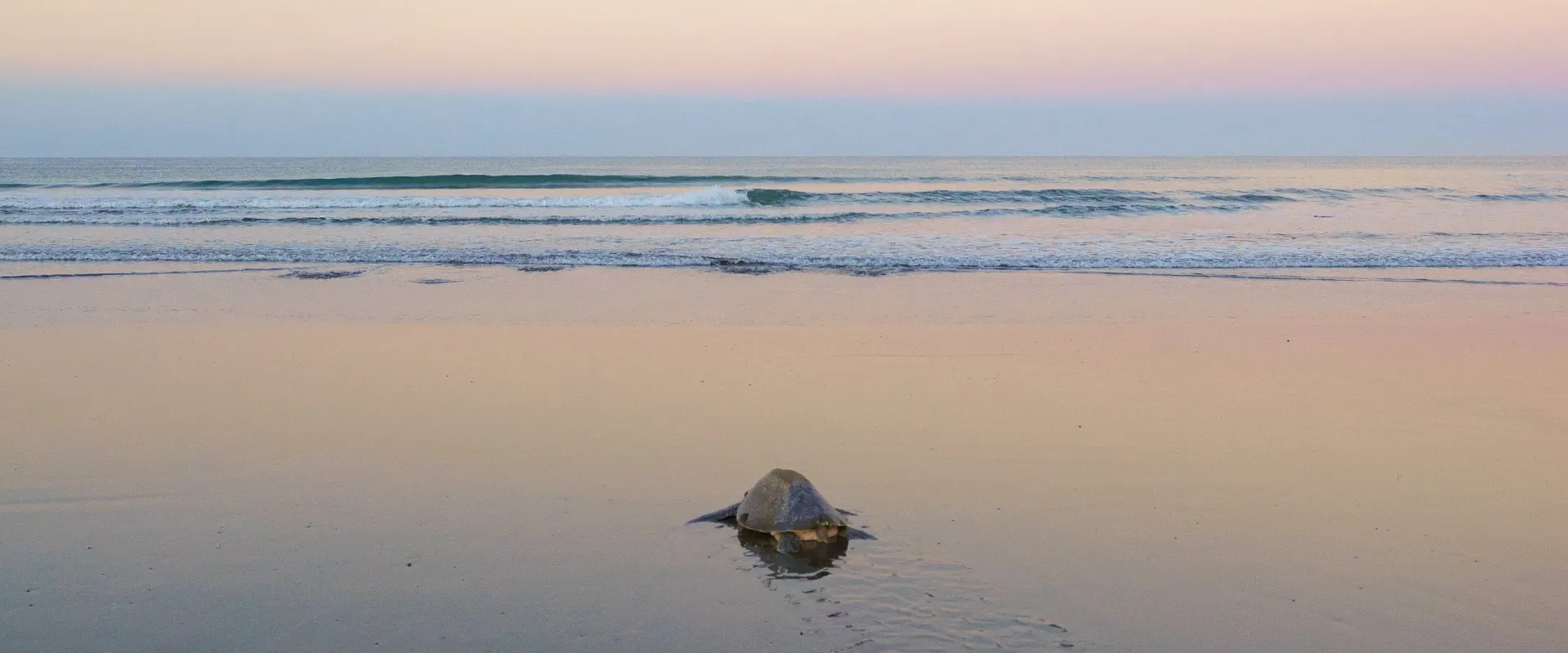
See Green Sea Turtles Nest in Costa Rica’s Tortuguero National Park
When the boat pulled into the small harbor of the remote, roadless village of Tortuguero—the only settlement within Costa Rica’s Tortuguero National Park—reggae music was floating through the afternoon air, past the multi-colored houses that lined the main walkway. The vibrant hues of the kilometer-long settlement was the first sign of human life we’d seen since climbing on board an hour and a half earlier.
As the park is only accessible by air or water, getting to the village had been an adventure in and of itself. We had left behind the misty central peaks of Arenal Volcano National Park in the early morning. As the shuttle bus drove eastward, mountains and lakes gave way to the lush sun-drenched province of Limón, the Caribbean heartland on Costa Rica’s lesser-traveled West Coast. We then climbed into a skinny turquoise motorboat at Caño Blanco dock, located on the southern edge of the park, and snaked our way through the park’s network of canals, keeping our eyes peeled for caymans and manatees.

The village is located on a narrow jut of land flanked by a canal on one side and a wild stretch of the Caribbean Sea on the other. It is enveloped by nearly 200,000 acres of protected jungle, rainforests, swamps, lagoons, and estuaries, which provide sanctuary to a Noah’s Ark of species. But I was here for one species, and one alone: the green sea turtle.
Tortuguero—which translates to “region of turtles”—lays claim to one of the most important nesting sites of the endangered green sea turtle in the Western Hemisphere, as well as important nesting populations of leatherback, hawksbill, and loggerhead turtles.
Not long after checking in to Casa MarBella—a simple but beautifully set hotel on the canal’s edge—we met Chamba. One of the hotel’s resident guides at the time, Chamba was leading our turtle nesting tour at Tortuguero Beach the next evening (turtles mainly nest at night).
A passionate conservationist and national park volunteer, Chamba took us out on an electric boat ahead of the turtle tour to explore the national park by water, wowing us with facts about yellow-throated toucans as they flew overhead and the mystical basilisk lizard—commonly known as the “Jesus Christ” lizard, as it seemingly walks on water to trap food and escape predators—that levitated past the mangroves.
The boat tour also gave us a chance to discuss the evening’s impending turtle expedition. “You must wear all black, and no phones or cameras,” Chamba instructed. I felt like we were going on a top-secret mission. “Do you think we’ll see a turtle laying her eggs?” I asked wistfully. “There’s no guarantee,” he replied.

By the 1950s, Tortuguero’s green sea turtle population was all but wiped out by poaching. Tragedy was narrowly avoided thanks to American zoology professor Dr. Archie Carr, whose book The Windward Road shined a light on the issue, leading to the establishment of the Sea Turtle Conservancy (STC) in 1959.
The nonprofit, which has a research station on the edge of the village, has spent over six decades working in hand with the local community toward the conservation of endangered turtles. The results are heartening, with the WWF reporting a 417% increase in the park’s turtle population from 1971–2003. Now, with up to 50,000 green sea turtle nests laid every year during nesting season, visitors have a reasonably good chance of encountering one.
The STC works to ensure turtle nesting tours—which are limited to groups of ten—have minimal impact. It does this via its Spotters program, which deploys local-trained sea turtle spotters on the beach during the nesting season to find nesting turtles before the guided tours arrive.

At 9:30pm, camera-less and camouflaged, we set off with Chamba, walking the dark jungle-lined pathway behind the village to Tortuguero Beach. As this is a vital ecosystem, most of the approximately 22 miles of volcanic-sand beach is off limits. However, visitors can access the village’s assigned public stretch before 6pm. Later visits must be accompanied by a guide.
We were in luck. An STC spotter radioed Chamba, and we emerged from the foliage onto the star-lit dunes. In the distance, there was a group standing around what looked like a crater with a growing mound of sand around its rim. We waited patiently until they moved away and Chamba signaled us forward. Then I saw her.
Around four feet long, she was much bigger than I had imagined. The trench she shoveled out with her moss-green back flippers was complete. Behind her was her nest, a smaller, deeper hole known as the egg chamber. Chamba shined a red-light flashlight so as not to startle her, and we watched on as an endless stream of round white eggs, each the size of a ping-pong ball, dropped into their temporary home with the hopeful promise of new life.
“Are we disturbing her?” I whispered to Chamba, acutely aware of the significance of what I was witnessing. “When turtles lay their eggs they go into a trance,” he reassured me. “She doesn’t know we are here.”

The spot near the top of the beach she had chosen was not by chance. It is likely that she herself had hatched nearby, possibly decades ago. We stayed for a couple of minutes and then gave her privacy, watching on from a distance as she began to cover her nest.
In around 60 days, her eggs (of which there were around 115) would hopefully hatch. Her hatchlings would push their tiny bodies up from the sand and make that same first journey toward the water that their mother had done years prior. Rarely—though it’s not impossible—some visitors are lucky enough to witness hatchings from late August through October.
Her nest hidden, the mother pulled herself back to the roaring Atlantic and disappeared into the black waves. With the nesting season nearing its end, it was unlikely that she came back ashore to lay another clutch that year. She probably wouldn’t return for another two or three years, until the magnetic draw of Tortuguero called her back once more.
Getting there
- There are no direct flights from the US to Tortuguero National Park. Most visitors will transit through San Jose (SJO). From San Jose, there are a few different ways that you can reach the park. You can take a short, regional flight to Tortuguero (TTQ) offered by domestic airline SANSA in one of its small turboprop jets. This is the quickest option. More common, however, is the flora- and fauna-rich journey by road and boat. There are many tour operators, but we opted for Exploradores Outdoors. The operator picked us up from our accommodations in La Fortuna and drove us by shuttle bus to Caño Blanco dock. From there, we boarded a boat to Tortuguero. (Other operators run from San Jose to Tortuguero via La Pavona dock.) Tickets typically cost less than $70 per person, and the journey is 4.5–5 hours, depending on where you set off from. You can also opt for the private transfer option, which is usually just as affordable and also saves time, as you avoid having to pick up other passengers. You can also drive yourself from San Jose to La Pavona dock and leave your car in a secure car park for about $10 per day.
- Average Going deal for cheap flights to San Jose: $321 RT
$600
How to do it
- Best time to go: Green sea turtle nesting season runs from July–October. There is a small chance of witnessing hatchings between late August and October.
- Cost: The turtle nesting night tour through Casa MarBella with a local guide costs approximately $31 (accommodations here start around $45 per night for a double room with breakfast). Tours with Chamba (who has since left Casa MarBella and is now a freelance guide) cost approximately $36. You can get more information on tours with Chamba via email. There are a number of other hotels and guest houses nearby, as well as a handful of local tour operators, that offer turtle nesting night tours for a similar price. Tours typically last around two hours, and the price includes a local contribution of $6 to support the Turtle Spotter program.
- Tips and considerations: Try to book your tour in advance. Bring dark clothes, including a waterproof jacket and closed-toe shoes.
Other animal encounters around the world
Published February 14, 2024
Last updated February 14, 2024
Articles you might like
View AllTreat your travel to cheap flights
Most deals are 40-90% off normal prices with great itineraries from the best airlines. If it's not an amazing deal, we won't send it. Sign up for free to start getting flight alerts.




